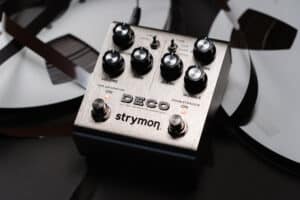
BigSky MX Preset Pack 1
Explore Our First BigSky MX Preset Pack! As part of the latest Nixie 2 update, we’ve put together a free BigSky MX preset pack featuring sounds
Free US Shipping On Orders Over $49
Easy 30-Day Returns
Financing Available Through ![]()
By now you probably know that if you own more than one or two pedals, you should be using a dedicated multi-output power supply. We offer four high-current pedal power supplies: Zuma, Zuma R300, Ojai, and Ojai R30.
Using a Strymon power supply to power your pedals comes with many benefits: no more having to wonder if the batteries inside your pedal are going to die on you mid-performance, no more lugging clunky power supplies for your power-hungry digital pedals, and no more noise from dirty power, ground loops, and daisy-chains. You just connect your pedal to the output that has the voltage you need, and you are good to go! It really is that simple.
That being said, at some point or another, we were all new when it came to the electrical side of things regarding our pedals, and a lot of questions came with that. Why can’t I use 12V for a 9V pedal? Can I use 500mA for my 100mA pedal? What is polarity? After all, with countless pedals out there in the world, there are also many different power requirements for those same pedals. Today we’ll be trying to help you answer some of these basic questions, as well as give you guidelines for one of the most common questions we receive: Will my Strymon Zuma or Ojai power my pedal?
First, we need to know some basic electrical terms. Knowing these will help to answer the question above almost 99% of the time. The three things we need to know when asking “Will my Strymon power supply power my pedal?” are current draw, voltage, and polarity. This isn’t an electrical engineering course, so we’ll present this in a simple way that just gives you the information you need.
The first thing we need to know is the current draw of a given pedal. Current draw, measured in milliamps (mA), can be thought of (roughly) as how much power a pedal needs. Analog pedals will usually require less than 100mA, while often digital pedals will require several hundred mA to power up. Less common tube-powered pedals sometimes require even more, some requiring several Amps (1 Amp = 1,000mA) to power up. One important thing to note about current is that pedals only use the current they need. This means that if a pedal requires 50mA, you can still connect it to a 500mA power source and it will work just fine, with no risk of damage or malfunction.
All Strymon power supplies put out 500mA at 9V, meaning that your Zuma or Ojai is easily able to power just about every pedal you’ll need – from your low-current analog pedals, to the processor-intensive digital modeling variety.
“Well, that’s all fine and good for 9V pedals, but what about 12V and 18V pedals?”
Excellent question, which leads us onto the next topic: voltage (V). Voltage is defined as electrical pressure, and can be thought of as the strength of an electrical current. This is a very important thing to know when it comes to pedals, as using the wrong current probably just means that your pedal won’t turn on, but using the wrong voltage could actually fry your pedal. Power supplies such as Zuma, Zuma R300, and Ojai R30 come with adjustable voltage outputs that can be set to 9V, 12V, or 18V. Combine that with their high current output, and the list of things that can’t be powered with a Strymon power supply is becoming increasingly short!
Finally, we have polarity. Most guitar pedals will have a power jack that has either a positive or negative center pin. This determines the pedal’s polarity, and is usually denoted by a small diagram near the power jack. Guitarists usually don’t worry about polarity that much, as most modern guitar pedals are DC (direct current) and center negative, as are most pedal power supplies. But polarity is also very important to be aware of, as using the wrong polarity (center positive power supply with a center negative pedal jack) can also damage your pedal.
The polarity symbols we find on our pedal’s and power supply’s connections help us to avoid using the wrong polarity. The symbol consists of three circles: one with a negative sign, one with a positive sign, and one circle that looks like the letter C, with a little dot inside it with a line tied to one of the other 2 circles. Whatever circle this center dot is tied to with a line denotes the polarity of the connection.

All Strymon power supplies have center negative outputs, so they will work to power the majority of pedals out there on the market without any needed adapter cables.
So now we know the three basics of pedal power: current, voltage, and polarity, and we also know that Strymon power supplies will power any DC center negative 9V pedal that needs 500mA or less. At 12V, our outputs will output 375mA of current, and at 18V, they output 250mA of current. While this covers the majority of pedals in existence, there are still some common questions we get regarding pedals that do not fit within these parameters:
Rest assured that if you have questions, we here at Strymon have answers for you.
Some pedals require 24V, and some even require 36V. To power these pedals, you’re going to want to use something called a voltage doubler in order to deliver the necessary voltage. These voltage doublers can be used to combine the voltage of two outputs (for example, two 12V outputs) and deliver that combined voltage (now 24V) to your pedal’s power input. We just happen to sell some voltage doublers here:
There are some voltage doublers out there that only use one output, and use an adapter to double the voltage of that single output. These work just fine, but be aware that they usually limit the current output to 100mA or so. Refer to the manufacturer of your specific voltage doubler for more information.
As briefly mentioned when discussing polarity, a few pedals require a center positive connection. The solution for this is a simple adapter that will reverse the polarity of the connected cable. Simply attach one of these to the end of the DC cable that is going to be connected to the center positive pedal, and you now have a center positive connection:
Often, center positive pedals also have a larger center pin for their power jack. We sell a 2.5mm reverse polarity cable for these situations:
Here’s a tip to see what size you need: take a disconnected standard DC power cable and connect it to your pedal. If it fits, you need the 2.1mm adapter. If it is too loose, you more than likely need the 2.5mm adapter.
As pedals become increasingly complex and powerful, some require more than 500mA of power! For these power-hungry behemoths, what you’ll want to use is a current doubler (NOT a voltage doubler!!) in order to combine the current output of two outputs of the same voltage. They work the same way as voltage doublers: simply connect across two outputs (for example, two 9V 500mA outputs) and you now get their combined current output (a now whopping 1,000mA at 9V.) We don’t currently make our own current doublers, but other manufacturers do sell some that work perfectly with our power supplies.
Some vintage pedals, like old Tube Screamers and Rats, used this type of power connection. For these pedals, a simple adapter is all that is needed. While we don’t make any at this moment, they are also easy to find anywhere that sells pedalboard accessories.
While we did our best to try and power every pedal under the sun, there is only so much you can fit within an enclosure as light and as compact as that of Zuma and Ojai without negatively affecting other aspects of a power supply’s performance. Powering AC pedals would have required us to include a traditional 50/60Hz transformer. These transformers are heavy and also have the capacity to introduce noise into pedals and magnetic components, which is something no guitarist wants.
For those less common AC pedals, or even for pedals that have an attached power cord (like vintage EHX pedals,) the best solution we can recommend is using an IEC splitter with an AC output. These IEC splitters still allow you to run just a single power cable to your board, while giving you two connections: an IEC end that connects to Zuma’s 100-240V input, and an AC outlet (just like the end of an extension cord) that can be used to connect the power supply for your AC pedals, or to connect pedals that have attached power cords.
There are times when maybe you’re not sure regarding a pedal’s polarity, current draw, voltage, or jack size. For these, your best resource will be the pedal’s user guide, and if that does not list the specs you are looking for, your best bet would be reaching out to the pedal’s manufacturer for more information on what the pedal’s power requirements are.
We hope you have enjoyed this article, and please remember that when in doubt, our support team is happy to help out! If there is anything we forgot to list in this article, or if you have a pedal that seems like it should work with our power supplies but for some reason doesn’t, never hesitate to reach out to us at [email protected] with any power questions you may have.
If you have any questions about these or any other Strymon products, please reach out to us at [email protected]. We have a ton of great information on our site and would love to hear from you as well. And check back regularly, as we’re adding new content all the time.
Have an idea for a blog or a question about Strymon, our products, or effects in general? Let us know!
Subscribe to our newsletter to be the first to hear about new Strymon products, artist features, and behind the scenes content!

Explore Our First BigSky MX Preset Pack! As part of the latest Nixie 2 update, we’ve put together a free BigSky MX preset pack featuring sounds

If you happen to be one of those Strymon owners who know that their favorite units might have some extra capabilities but can’t remember exactly

From our favorite artists’ new releases to amazing concerts, and existing artists we’re just finding out about, 2024 was a year filled with great music.
20 Responses
Does the voltage doubler cable function in reverse? Say I have 2 pedals that requires in total less than 500mA, can I use the voltage doubler to connect one port of my Ojai to the two pedals?
Hey there Paolo. You wouldn’t want to use a voltage doubler for that, but rather an output splitter. From there you can connect multiple pedals as long as they do not require more current than what the output can provide. Keep in mind that daisy-chaining like this may result in noise.
Do you recommend a good Y/Splitter cable so I can run 2 overdrives from one output on my Zuma?
Something like this should work: https://store.truetone.com/mc2-5-5-x-2-1mm-plug-socket/
Tried the link on 2023 NOV 20 MON. Connected to truetone, but not to a product page. It’s no problem for me. I already have some Y cables. Just letting you know the link is now out of date. Anyway, folks can custom order any kind of splitter cables from cablematters dot com. Maybe from truetone as well. But what are the actual specs of the type of splitter cable needed? You would have to know that, in order to describe what you want to buy or custom order.
Thanks for pointing this out!
It just needs to be a 2.1mm to two 2.1mm outputs, and you just have to make sure it’s not a voltage doubler.
Here’s another option.
https://www.sweetwater.com/store/detail/PPAV–voodoo-lab-output-splitter-adapter-4-inch-str-str-y
I’m thinking of getting an Electro Harmonix Pog 2 .. Will my Zuma power it .. Thank you..👍🏻🌞⭐️❤️
I would say yes, but we haven’t tried that EHX pedal specifically, and sometimes some of those EHX pedals are tricky since they state they need 9.6V. I’d reach out to EHX to see if they know with any certainty.
I have a Gallien Kruegar Plex Pedal and it requires 9Vdc minimum current 500mA centre negative. I have both the Ojai and Zuma and neither power the pedal. I have tried a current doubler and the result is no different.
Any suggestions on what’s going on?
It could be an issue with the power ramp up. Please email us at [email protected] and we’d be happy to look into this with you!
Can I use a power doubler to combine 2 9v outlets to power an 18v pedal?
Yes, you can use a voltage doubler across two 9V outputs to get a 18V connection 🙂
I have a Strymon Ojai power supply unit on my peddleboard. I have just acquired a Boss RE201 space Echo pedal which requires, it says, a Boss PSA adapter. Can I get it to work with my Strymon?
Shoot us an email to [email protected], and we can go ahead and take a look 🙂
I am having the same problem with a C9 on a Strymon Zuma supply. I tried multiple C9’s and none would work with the Zuma. But they of course worked with the 9.6V EH supply.
I found the POG2 worked fine with the Zuma, and swapped to that.
I’m being told by Electo-Harmonix this is a ramps issue with the Zuma, and is a known problem.
I there anything I can do to adjust one of the jacks on the Zuma to 9.6V? Will that fix the problem, or is this a current inrush issue. All of my other pedals work fine.
I have a line 6 m5 and I would like to power it with my strymon ohja power supply the strymon fits but it appears to long as all the metal does go In flush with the m5 please help
Hey Bill! Please shoot us an email to [email protected] and we can assist. Thanks!
I have my pedalboard with 9 pedals powered with two Strymon Ojai’s. Sometimes my GFI System Synesthesia and Strymon Timeline will begin flickering like they’re not getting enough power/current. I’ve read that these power supplies should be able to give 500mA per output, but that doesn’t seem to be the case I guess? Thoughts?
In the event we have more 9v pedals than unique 9v outputs available on the power supply can we daisy chain one output? Also, when daisy chaining, does the current draw add up from each pedal? Example, if I have 6 pedals each requiring 100mA does the power source need to be 600mA? I believe the answer is: no, you could daisy change a 100mA power source for all 6 pedals, but I wanted to refresh my memory. Thanks
You can certainly daisy chain, but we only recommend doing so with low-current draw analog pedals, as doing so with digital pedals can lead to noise. Even daisy chaining simpler pedals can sometimes lead to noise, so just something to be aware of. And yes, the current draw adds up — for example two 100mA pedals off the same output would draw 200mA of current.